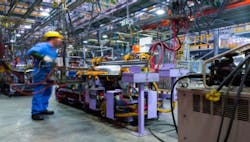Webinar Snippet: Reimagine the factory floor for the manufacturing workforce
Imagine a new employee's first week on the job at a manufacturing plant. First comes tackling the HR checklist: completing a slew of paper documents. Throughout the week, various onboarding tasks from other departments, such as IT and Facilities, roll in—likely involving more paperwork.
How are decades of experience and institutional knowledge transferred to the new hire? Normally it happens through a thick and daunting binder, perched on the new hire’s desk, which may or may not be complete. Meanwhile, the employee starts the time-consuming task of figuring out how to do their job. It’s a big enough challenge under any circumstances—but even more so if that employee is replacing a long-tenured, recently retired worker.
Now, imagine how this transition impacts the rest of the plant. Nothing works quite as efficiently as it’s supposed to while they wait for the new hire to get up to speed on production processes and how things are supposed to work.
The approach doesn’t work well for people or production, especially when it needs to scale to hundreds or thousands of employees as a wave of retirements loom.
It’s time to reimagine how we align people and production. To maintain success, we need to give everyone the tools they need to work effectively, whether it’s their first day on the floor, or they have decades of experience.
Still, it’s not easy to change how work flows across your organization. Let’s take a closer look at three major challenges that digitization must tackle head-on.
Workforce challenges in the Industry 4.0 era
Even as smart factory advancements have led to modernization and automation in production, the manufacturing workforce still has a key role to play. In fact, as operational technology evolves, manufacturers need skilled talent who can manage and secure it. But the workforce challenges that manufacturers are facing have evolved just as quickly as their technology.
- Transferring knowledge from retiring workers Industry 4.0 has ushered in the need for more digitally skilled workers just as manufacturing faces a looming talent tsunami: 2.6 million Baby Boomers are poised to retire by 2030. These trends point to an estimated 2.1 million unfilled manufacturing positions, costing the U.S. economy as much as $1 trillion, according to the 2021 Deloitte and The Manufacturing Institute Manufacturing Talent study.
These challenges are forcing manufacturers to evolve their approach to training and onboarding talent. The workforce of the future will need to bring with it skills to maintain a smart factory, while still filling the workforce gaps left by retirees. Manufacturers increasingly need employees to manage Industrial Internet of Things (IIoT) devices, review analytics, and oversee more technologically advanced operations. At the same time, even the most digitally advanced production lines need humans to keep operations flowing. To help solve for this, manufacturers should consider digital solutions that allow them to quickly and efficiently upskill and onboard talent. - Reducing human error. Human error continues to be the primary cause of factory downtime today. In fact, human error is the primary cause of 70-80% of downtime issues, compared with 20% that are attributed to equipment failures, according to IHS Markit. One of the main tools for combating human error is standard operating procedures (SOPs)—many of which are recorded in physical or paper manuals, or otherwise manually relayed between employees. But what happens when someone misplaces a manual that guides their work? What if someone tweaks the process but fails to record it for the next person? A reliance on physical SOPs creates inconsistencies over time, which can affect plant safety. Digitally recording SOPs gives manufacturers a more reliable way to capture information, especially as things evolve, and an easier way to share it.
- Improving safety and compliance. Since the back office is ruled by manual processes and information is stored across different systems and spreadsheets, information silos are rampant. It makes it difficult for anyone to have a true understanding of the big picture in real time–from the onboarding status of new employees to employee safety to compliance issues. Manufacturers need a better way to bring disparate data together to make smarter, faster decisions and drive continuous improvement.
Success will increasingly be influenced by a workforce that achieves more using fewer resources. Manufacturers must empower their workforce with digital and mobile tools that help them respond and adapt to fast-changing conditions.
About the Author
James Destro
James Destro is head of product, manufacturing with ServiceNow.
